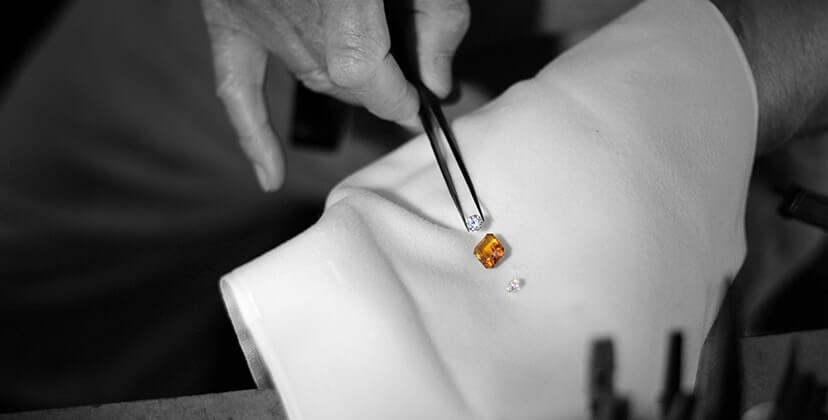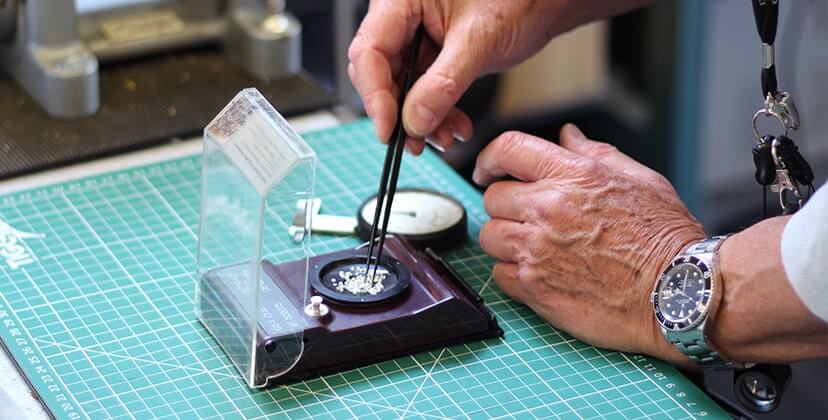“Diamond prices depend on carats – right?”
“Well no – not necessarily…..”
About Diamond Quality
The carat is an ancient unit of weight – now taken to be equivalent to 0.2 gram. A 1 carat diamond is twice the weight and obviously more valuable than a ½ carat stone of the same quality. Not just twice as valuable either – since larger stones are more rare their price per carat is higher. Hence the 1 carat stone may be, say 4 times the price of the ½ carat..

BUT the catch lies in the phrase ‘of the same quality’. The quality of a polished diamond depends on three factors COLOUR, CLARITY and CUT. Grading a stone for this quality is a highly specialised skill – but a good quality stone will always outshine a lesser example and is considerably more valuable.
As a result, a ½ carat top quality stone could be worth 4 times as much as a low quality 1 carat – completely reversing the situation! (But these would be extremes of quality).
This is of no importance at all to many people – to wear a 1 carat stone may be more desirable than a ½ carat regardless of some arcane concept of quality which the wearer may not be able to discern anyway.
But for those romantics in thrall to the peerless beauty of this natural gem, or for those hard headed buyers concerned about investment value …quality is all.

For large-stone jewellery, most high-class jewellers will not normally use diamonds below the middle band of the quality range of gem diamonds. But top end suppliers such as Cartier only offer stones from the upper sector.
Roger prefers to use only these better quality stones – beginning typically with ‘G’ colour and ‘VS’ clarity. These quality grades are defined by the gem laboratories that issue diamond certificates – such as the Gemological Institute of America (GIA). Colour, or more accurately the absence of any yellow/grey tint, is graded on an alphabetic scale from D to Z (but N colour stones or below are not normally used in good jewellery and are termed simply ‘tinted’). ‘VS’ stands for Very Slight and refers to the extent of tiny ‘inclusions’ which are almost always present to some degree within natural diamonds.
The truly colourless (D) internally flawless (IF) diamond is a rare commodity, but Roger has always been able to supply these when requested. Even more rare are natural strong pink, blue, yellow or green diamonds that break all the rules on colour – but if that’s your dream, then just ask.
Diamond Grades – an Imperfect Guide
But remember, while jewellery can be made to order, each diamond first has to be found – and then cut. The quality and integrity of cutting are a vital component of the diamond’s beauty.

Quality cannot be summarised by just the G VS1, D IF grading system. Roger sources and carefully selects the stones individually for each client to ensure they get the best possible stone for their budget. D IF graded diamonds, the ‘flawless’ stone, will still vary in beauty according to the quality and integrity of the cut – particularly for the different shapes of stone. In a recent international search for a 1 carat D IF marquise diamond, roger rejected four stones, all certificated by the GIA as D IF, before finding one of true beauty for a discerning client.
Roger would be happy to discuss any queries you have on this or any other jewellery subject
– Just visit the Studio
“My pendant is much admired. I had to take my son’s watch to the jeweller near my office and the staff (5 in total and different ones each visit) all commented on my pendant, remarking on the diamond’s brilliance and the unusual setting. Just wanted to let you know, the professionals admire it as much as I do.”
